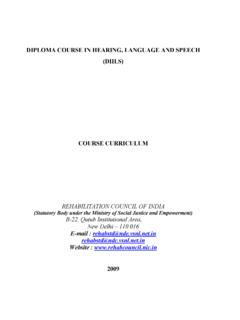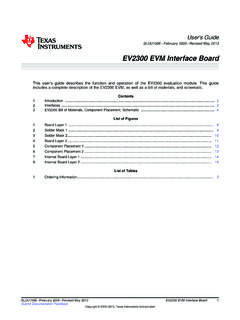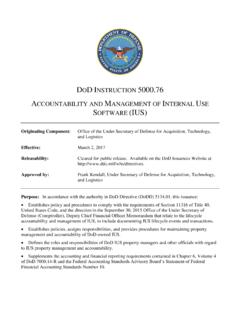Transcription of VISUAL IMPAIRMENT - Rehabilitation Council of India
1 VISUALIMPAIRMENT357 The visually handicapped have passed throughvarious stages: of being treated as rejects ofthe society to being recognized as talented personswho were no inferior to their sighted their status of being more akin to objectsthan living beings in antiquity, the visuallyhandicapped have passed through the phases ofgetting social protection during the Judaic andChristian periods in the West, more forconsideration of body than soul (Kirtley, 1975).International Efforts for the Education ofthe BlindPrior to the 80s blind people were mainlyself-taught, often being given appropriateassistance. France was the cradle of new attitudestowards the blind and started the first school forblind children.
2 The philosophical groundwork waslaid by Diderot, an enlightened philosopher andphysician to King Louis XV. In 1749, he published Letter on the Blind for the Use of Those WhoSee .The next giant step was taken in Paris in 1784by Valentin Hauy when he established theInstitution des Jeunes Aveugles (Institution forBlind Youth). Admiration for their competence,not pity for their blindness, was what Hauy hopedto engender for his students. In spite of politicalupheavals in France and in the life of his school,Hauy s contribution was a lasting one. He foundedthe first school for blind children, which was tobecome a model. He emphasized reading andfostered the development of embossed in the vocational potential of blindpeople, he introduced vocational training in of the blind children received afurther boost by 1834 with the successfuladaptation and development of the embossed dotcode by Louis Braille, a Frenchman, himself this time, blind people did not have anefficient system of reading and writing.
3 Thereforethe code which bears Braille s name, still taughtaround the world, ushered in an era of easiercommunication among the blind themselvesopening the doors for the acquisition ofinformation and knowledge through the sense s success led to the establishment ofsimilar institutions in Europe, including the firstschool for the blind in Liverpool, England, in half a century after the founding of Hauy sinstitution, the first school for the blind childrenwas opened in the United States. Three privateschools were then founded almost are presently known as Perkins School forthe Blind (1829), the New York Institute for theBlind (1831), and Overhrook School for the Blind(1833).Organized Efforts for the Education ofthe Blind in Pre- and Post-IndependentIndiaThe residential model was rapidly replicated, chapter 1 Historical Perspective358not only in the USA but also beyond the shores ofEurope and North America.
4 The missionariesarrived in Asia and other parts of the world beforethe turn of the 19th Century, to offer educationand Rehabilitation services to blind people. In India ,Miss Annie Sharp, a Christian missionary fromEngland, founded the first school for the blind inAmritsar in 1887. There were just four schools forthe blind at the turn of the Century. But the effortsin this direction by the voluntary organizations andthe Christian missionaries continued. By 1944,when the report on blindness in India wassubmitted, there were 32 schools in undividedIndia. Most of these schools were being managedby private agencies, with grants from some landmarks in the history ofeducation of the visually handicapped in India level decision to establish a Braillepress to produce books in Braille in could not be implemented due tonon-existence of a uniform Braille codefor Indian up of a Committee in 1941 bythe then Govt.
5 Of India to develop auniform Braille code for of the Report on Blindnessin India (1944) which is the basis of mostof the services for the blind up of a Cell in the Ministry ofEducation in 1946 to promoteeducation, training and Rehabilitation ofthe and acceptance of Bharthi Braille , a common Braille codefor Indian languages finalized inNovember 1950, replacing the earliercodes in the light of certainrecommendations made by up of the first Braille press atDehradun in of National Associationfor the Blind in 1952 marking thebeginning of concerted voluntary actionin the up of first Vocational TrainingCentre for the Adult Blind Women in1957 at of the first School for theBlind by the Central Govt.
6 In January1959 at Rajpur, Dehradun (now locatedin the campus of NIVH, Dehradun).10. Institution of the first Light Engineeringcourse in 1961 at Establishment of the first NationalLibrary for the Blind by the CentralGovernment in Govt. of India brought all its activitiesfor the education, training andrehabilitation of the blind under oneumbrella for better coordination in 1967called National Centre for the Blind, A review of the Government initiativein 1973-75 to gauge the impact of itsschemes for the welfare of the blind ledto the decision to set up one apex levelInstitute in each disability area by thethen Ministry of Social Welfare(presently the Ministry of Social Justice& Empowerment).
7 14. Establishment of the National Institutefor the Visually Handicapped (NIVH)on 2nd July 2 Incidence and Prevalence ofVisual ImpairmentIncidence means the number of persons bornwith VISUAL IMPAIRMENT or who acquiredimpairment per 1,00,000 population during 365days prior to survey. Prevalence means the numberof persons born with VISUAL IMPAIRMENT or becamevisually impaired per 1,00,000 population in thecountry till the date of survey. The data availableby NSSO and/or Census gives the prevalence andnot the of VISUAL IMPAIRMENT inIndia According to NSSO (2002)NSSO defined VISUAL disability as loss or lackof ability to execute tasks requiring adequate visualacuity. For the survey, visually disabled included(a) those who did not have any light perception both eyes taken together, and (b) those who hadlight perception but could not correctly countfingers of hand (with spectacles/contact lenses ifhe/she used spectacles/contact lenses) from adistance of 3 metres (or 10 feet) in good day lightwith both eyes open.
8 Night blindness was notconsidered as VISUAL the country, 45,571 rural and 24,731urban households were surveyed in rural and urbanareas, respectively from 4,637 villages and 3,354urban blocks. The number of disabled personsenumerated was 49,300 in rural and 26,679 inurban India . According to the survey estimates, thenumber of disabled persons in the country million during July to December, 2002, andthey formed about per cent of the totalestimated and Incidence of VisualDisability A ComparisonA comparative analysis of VISUAL impairmentin different rounds of NSSO is given in Table prevalence and incidence of visuallydisabled persons per 1,00,000 persons is given inTable 1 for rural and urban areas. For the countryas a whole, the prevalence of VISUAL disability hasdecreased marginally between 1981 and 1991, andsubstantially between 1991 and 2002 (Table 2).
9 This is true of incidence rates too. With betterhealth care facilities over time, ailments such asdiarrhoea, cataract, glaucoma, etc., might have beenprevented to a large extent during the recent may also be noted that a large proportion ofpeople are using spectacles to improve their , VISUAL disability is judged depending uponwhether one is using spectacles or total estimated population for 1st October, 2002, is obtained by applying decennial (exponential) growth rate ofpopulation for 1991 2001 on Census 2001 2: NSSO Report PrevalenceYearRuralUrbanTotal1981 34,70,000199133,35,0006,70,00040,05,0002 00222,57,5005,69,20028,26,700 Source: NSSO Report, 1: Prevalence and Incidence of Visually Disabled Persons per 1,00,000 PersonsObtained from NSSO 36th, 47th and 58th RoundsAll-India36th round47th round58th roundSector(July December, 1981)(July December, 1991)(July December, 2002)MaleFemalePersonsMaleFemalePersonsM aleFemalePersons(1)(2)(3)(4)(5)(6)(7)(8) (9)(10)Prevalence rateRural444670553471548525276326296 Urban294425356263346302163228194 Incidence rateRural324538222825101613 Urban2338301525207109 Table 3.
10 Age Group and VISUAL IMPAIRMENT (Number of disabled persons per 100,000 persons)AgeRuralUrbanGroupBlindnessLowBl indnessLowVisionVision0 43253055 94812731610-145222821015 195621441320 246523561825 296817432030 347716301935 397532532040 4412843793045 49183651053950 542661241829855 5943123428312260 & above17337471087459 ALL2108614054 Source: NSSO Report, 4: Age at the Onset of VISUAL Disability(Per 1000 distribution of persons 60 years and above with blindness or low vision by age at onset of disability)CategoryDisabilityAge at onset (years)AcrosssincethebirthCountry(1)(2)( 3)(4)(5)(6)(7)(8)(9)(10)(11)(12)(13)Blin dnessRural male2158742210451966991000 Rural female1781084685262386731000 Rural persons 197974457342206841000 Urban male18661054119233016061000 Urban female9125914017212886331000 Urban persons 139510102112222946211000 All male2157742212412146831000 All female158986575252466661000 All persons187885458322336731000 Low visionRural male13264320262347291000 Rural female28530120122597081000 Rural persons7653121192487171000 Urban male120140010152317271000 Urban female22030700252547091000 Urban persons51030410212457161000 All male13254320272337291000 All female27430210142587081000 All persons654312111124871710000 - 45 - 910 - 1415 - 1920 - 2425 - 2930 - 3435 - 4445 - 5960 &AboveTotalIt is observed from the above tables that theprevalence rate is highest in













